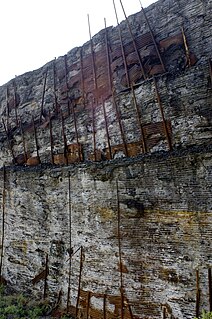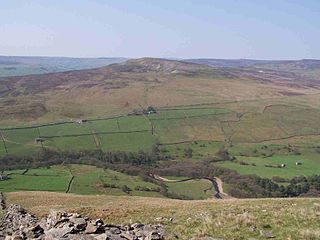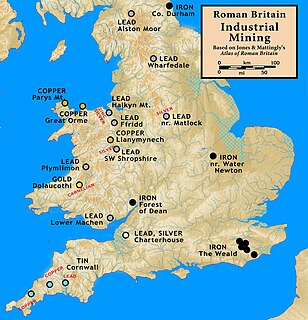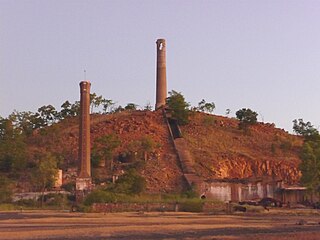
Smelting is a process of applying heat to ore in order to extract a base metal. It is a form of extractive metallurgy. It is used to extract many metals from their ores, including silver, iron, copper, and other base metals. Smelting uses heat and a chemical reducing agent to decompose the ore, driving off other elements as gases or slag and leaving the metal base behind. The reducing agent is commonly a fossil fuel source of carbon, such as coke—or, in earlier times, charcoal. The oxygen in the ore binds to carbon at high temperatures due to the lower potential energy of the bonds in carbon dioxide. Smelting most prominently takes place in a blast furnace to produce pig iron, which is converted into steel.

Slag is the glass-like by-product left over after a desired metal has been separated from its raw ore. Slag is usually a mixture of metal oxides and silicon dioxide. However, slags can contain metal sulfides and elemental metals. While slags are generally used to remove waste in metal smelting, they can also serve other purposes, such as assisting in the temperature control of the smelting, and minimizing any re-oxidation of the final liquid metal product before the molten metal is removed from the furnace and used to make solid metal. In some smelting processes, such as ilmenite smelting to produce titanium dioxide, the slag is the valuable product instead of the metal.
William Humfrey (c.1515–1579) was an English goldsmith, mining promoter, and Assay Master at the Royal Mint during the reign of Elizabeth I.

Copper extraction refers to the methods used to obtain copper from its ores. The conversion of copper consists of a series of physical and electrochemical processes. Methods have evolved and vary with country depending on the ore source, local environmental regulations, and other factors.

This article details some of the history of lead mining in Derbyshire, England.

Cupellation is a refining process in metallurgy where ores or alloyed metals are treated under very high temperatures and have controlled operations to separate noble metals, like gold and silver, from base metals, like lead, copper, zinc, arsenic, antimony, or bismuth, present in the ore. The process is based on the principle that precious metals do not oxidise or react chemically, unlike the base metals, so when they are heated at high temperatures, the precious metals remain apart, and the others react, forming slags or other compounds.

Arkengarthdale is a dale, or valley, on the east side of the Pennines in North Yorkshire, England. Running roughly north-west to south-east, it is the valley of the Arkle Beck, and is the northernmost of the Yorkshire Dales. It is a subsidiary dale to Swaledale, which it joins at Reeth.

De re metallica is a book in Latin cataloguing the state of the art of mining, refining, and smelting metals, published a year posthumously in 1556 due to a delay in preparing woodcuts for the text. The author was Georg Bauer, whose pen name was the Latinized Georgius Agricola. The book remained the authoritative text on mining for 180 years after its publication. It was also an important chemistry text for the period and is significant in the history of chemistry.

Calver Hill is a fell in the Yorkshire Dales National Park in North Yorkshire, England. It is composed of limestone and is situated at grid reference NZ012003, near where the valleys of Swaledale and Arkengarthdale meet, the village of Reeth is located on its lower south-eastern slopes, it reaches an altitude of 487 metres and is a distinguished feature in mid Swaledale. Calver Hill is an area of grouse shooting and the fell is dotted with grouse butts. Most of the drainage from the fell goes north and easterly to join the Arkle Beck in lower Arkengarthdale which eventually joins the River Swale just south of Reeth.
A Bole hill was a place where lead was formerly smelted in the open air.

Mining was one of the most prosperous activities in Roman Britain. Britain was rich in resources such as copper, gold, iron, lead, salt, silver, and tin, materials in high demand in the Roman Empire. The Romans started panning and puddling for gold. The abundance of mineral resources in the British Isles was probably one of the reasons for the Roman conquest of Britain. They were able to use advanced technology to find, develop and extract valuable minerals on a scale unequaled until the Middle ages.

Mount Isa Mines Limited ("MIM") operates the Mount Isa copper, lead, zinc and silver mines near Mount Isa, Queensland, Australia as part of the Glencore group of companies. For a brief period in 1980, MIM was Australia's largest company. It has pioneered several significant mining industry innovations, including the Isa Process copper refining technology, the Isasmelt smelting technology, and the IsaMill fine grinding technology, and it also commercialized the Jameson Cell column flotation technology.

Hushing is an ancient and historic mining method using a flood or torrent of water to reveal mineral veins. The method was applied in several ways, both in prospecting for ores, and for their exploitation. Mineral veins are often hidden below soil and sub-soil, which must be stripped away to discover the ore veins. A flood of water is very effective in moving soil as well as working the ore deposits when combined with other methods such as fire-setting.
Metals and metal working had been known to the people of modern Italy since the Bronze Age. By 53 BC, Rome had expanded to control an immense expanse of the Mediterranean. This included Italy and its islands, Spain, Macedonia, Africa, Asia Minor, Syria and Greece; by the end of the Emperor Trajan's reign, the Roman Empire had grown further to encompass parts of Britain, Egypt, all of modern Germany west of the Rhine, Dacia, Noricum, Judea, Armenia, Illyria, and Thrace. As the empire grew, so did its need for metals.

The Chillagoe smelters is a heritage-listed refinery at Chillagoe-Mungana Caves National Park, Mareeba Mining District, Chillagoe, Shire of Mareeba, Queensland, Australia. It operated in the early 1900s. It is also known as Chillagoe State Smelters. It was added to the Queensland Heritage Register on 21 October 1992.

The Bunker Hill Mine and Smelting Complex, was a large smelter located in Kellogg, Idaho, in the Coeur d'Alene Basin. When built, it was the largest smelting facility in the world. It is located in what became known as the Silver Valley of the Coeur d'Alene Basin, an area for a century that was a center of extensive silver and other metal mining and processing. This resulted in extensive contamination of water, land and air, endangering residents including the Coeur d'Alene Tribe, which had traditionally depended on fish from the waterways as part of its subsistence.

Plants for the production of lead are generally referred to as lead smelters. Primary lead production begins with sintering. Concentrated lead ore is fed into a sintering machine with iron, silica, limestone fluxes, coke, soda ash, pyrite, zinc, caustics or pollution control particulates. Smelting uses suitable reducing substances that will combine with those oxidizing elements to free the metal. Reduction is the final, high-temperature step in smelting. It is here that the oxide becomes the elemental metal. A reducing environment pulls the final oxygen atoms from the raw metal.

The ISASMELT process is an energy-efficient smelting process that was jointly developed from the 1970s to the 1990s by Mount Isa Mines Limited and the Australian government’s Commonwealth Scientific and Industrial Research Organisation ("CSIRO"). It has relatively low capital and operating costs for a smelting process.

Kuridala Township site is a heritage-listed mining camp in the locality of Kuridala, Shire of Cloncurry, Queensland, Australia. It was built from 1880s to 1920s. It is also known as Hampden Township, Hampden Smelter, Kuridala Smelter, and Friezeland Township. It was added to the Queensland Heritage Register on 12 June 2009.

Grinton Smelt Mill is a ruined lead mining and processing site on Cogden Moor, south of Grinton in Swaledale, North Yorkshire, England. The site was built in its present form c. 1820 for the specific purpose of processing lead won by hushing and hydraulic mining. The buildings and stone flue are now grade II* listed structures and all are scheduled monuments. The site is recognised as being the best preserved lead mining site in the Yorkshire Dales.
















